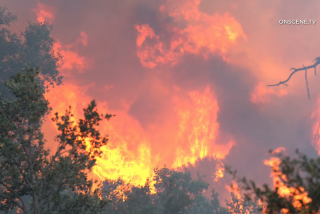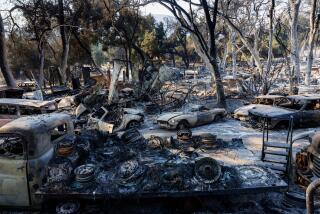Colorado fires: Waldo Canyon blaze grows, takes hundreds of homes
The devastating fire near Colorado Springs, Colo., continued to grow Thursday, even as the city began to assess the damage thus far; the threat to Boulder, Colo., from a separate fire, meanwhile, began to recede.
“We now know hundreds of homes have been destroyed,” Colorado Springs Mayor Steve Bach said at a Thursday morning news conference about the Waldo Canyon fire. He said he expected to soon get a fuller accounting of the blaze’s destruction, which some published sources have put at 300 homes. More than 32,000 people in Colorado’s second-most-populous city and its environs have been forced from their homes because of the fire.
The blaze, which began Saturday, remains at just 5% contained, according to the daily update from the scene. As of Thursday morning, 18,500 acres have burned – up from the 13,500 reported Wednesday.
On Tuesday, the damage was at 6,200 acres until fierce winds more than doubled the burn area overnight, prompting the evacuations; among those evacuated were thousands of people from the U.S. Air Force Academy.
The Waldo Canyon fire is just one of several burning in Colorado and in several other Western states. But the fire in Colorado Springs has been one of the fastest-moving and remains unrestrained. President Obama will visit the area Friday and has already pledged federal help.
In Boulder, the Flagstaff fire, about 1.5 miles outside the city, remains a threat, but less so than earlier in the week. Officials said that about 300 acres have burned and that the fire was about 30% contained. “We are in much better shape today,” Boulder County Sheriff Joe Pelle told reporters Thursday.
The state’s largest fire, the High Park fire, about 15 miles west of Fort Collins, Colo., was about 75% contained. More than 87,200 acres have been consumed since the fire began June 9. Full containment is expected around July 15.
Much of the state’s attention has been riveted on the Waldo Canyon fire because it’s burning in a significant tourist area with a high population. That the fire was small then suddenly erupted to dangerous levels heightened the drama.
The key ingredient to the fire’s growth has been the weather -- triple-digit temperatures, low humidity and high winds -- particularly in the evening and nighttime hours, fire officials said. But Thursday’s forecast of temperatures in the 80s and humidity as high as 15% to 20%, offered some hope.
Waldo Canyon incident commander Rich Harvey told reporters at the news conference that “yesterday was a good day” in fighting the fire. “We are going to be incredibly aggressive.”
More than 1,200 firefighting personnel are on the scene, along with hundreds of emergency workers. “We have resources on this fire from an alphabet soup of agencies,” Harvey said. “Our resources have wheels, they have tracks, they have rotors, they have wings.”
The fire burned about 10 acres along the southwest boundary of the Air Force Academy campus. No injuries or damage to structures were reported, officials said. The cadet area has not been threatened, though more than 2,100 people in 600 houses were evacuated earlier this week.
The danger from exploding houses made assessing the damage difficult, officials said. But more than 20,000 residences and 160 commercial structures were within the fire’s spread. Officials said more than $3.2 million has been spent fighting just the Waldo Canyon blaze.
The conditions that made Colorado a target for wildfires exist in other western states. Blazes are also being fought in Utah, Montana and Nevada.
ALSO:
Alien invasion? That’s OK with most Americans
Texas man gets 40 years in ‘stand your ground’ slaying
First black Marines get Congressional Gold Medal for WWII service
Join Michael on Google+. Email: michael.muskal@latimes.com
More to Read
Sign up for Essential California
The most important California stories and recommendations in your inbox every morning.
You may occasionally receive promotional content from the Los Angeles Times.











